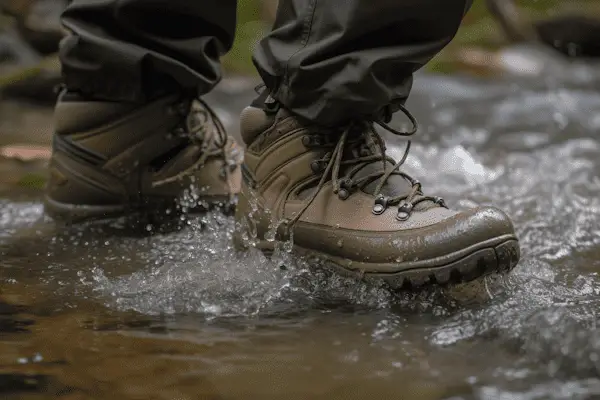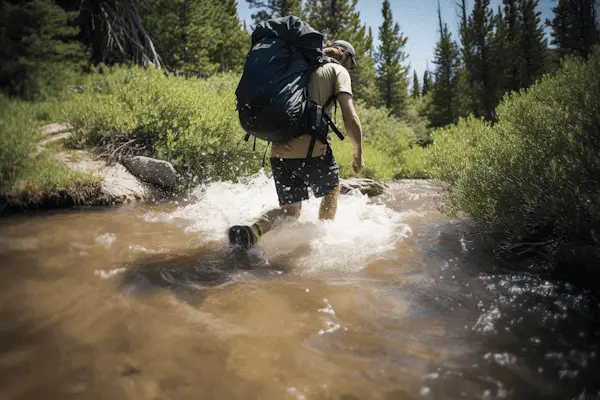You know how it is – you’re out on the trail, living the dream, when suddenly your boots are squelching with every step. Not fun, right? Soggy feet can turn a great hike into a complete nightmare, leaving you with cold, damp toes and possibly some nasty blisters to boot. No one wants that!
So what’s the solution? You’ve got it – waterproofing your hiking boots. And not just once, but regularly. It’s like giving your boots a superpower, protecting your feet from all sorts of weather while making your boots last longer, too.
This article is going to dive right into the world of boot waterproofing. We’ll share all the best tips and tricks to keep your feet as dry as a desert, even if it’s raining cats and dogs. By the end, you’ll be a waterproofing wizard, ready for any trail, any time. So, let’s get started, shall we?

Table of Contents
Understanding the Materials: Leather vs. Synthetic Hiking Boots
Okay, first things first – let’s talk about what your boots are made of. Not all boots are created equal, and the material yours are made from can make a big difference when it comes to waterproofing.
Are your boots leather or synthetic? Leather boots can be a bit more high maintenance, but they’re seriously worth the effort. They’re durable, long-lasting, and when you treat them right, they’re great at keeping water out. The thing with leather, though, is that you need to keep them well-conditioned so they don’t dry out and crack. Remember, we’re trying to avoid those dreaded soggy feet, not create more problems!
Now, if you’re waterproofing hiking boots made from a synthetic material, they’re a bit of a different beast. Synthetic materials – think nylon or polyester – are generally more lightweight and faster-drying than leather, but they might not be as naturally water-resistant. The good news is that there are plenty of waterproofing products out there that work wonders on synthetic boots.
So, bottom line? Whether you’ve got leather or synthetic boots, they can definitely be made to repel water. It’s just about knowing how to treat them right – which is exactly what we’re going to dive into next. Let’s do this!
The Basic Anatomy of a Hiking Boot
Alright, before we dive into the nitty-gritty of waterproofing, let’s have a quick chat about the basic bits and pieces that make up your hiking boots. After all, it’s like knowing what’s under the hood of your car – it just helps you take better care of it.
First up, we’ve got the upper. This is the part of the boot that wraps around your foot and ankle. It’s usually made of leather or synthetic material, and it’s what we’re focusing on when we talk about waterproofing.
Then there’s the midsole. It’s tucked in between the upper and the outsole, and it’s there to provide cushioning and shock absorption – basically, it’s what keeps your feet from feeling like they’ve hiked a marathon even when they have.
The outsole is the rubber part at the very bottom of the boot – the part that keeps you from slipping and sliding all over the trail. It’s usually made of tough, durable material, because it has to stand up to everything from sharp rocks to mud and everything in between.
And finally, we have the tongue and the collar. The tongue of the boot slides under the laces and over the top of your foot, while the collar wraps around your ankle. These parts need some waterproofing attention, too, especially if you’re planning to wade through any streams or puddles!
Now that we’ve got the boot basics covered, we can get to the really fun stuff – actually waterproofing those babies. Stick with me – it’s going to be a blast!
Step-by-Step Guide: How to Waterproof Your Hiking Boots
Alright, now we’re getting to the good stuff! Time to roll up your sleeves and make some water-resistant magic happen. Let’s break this down step-by-step.
Cleaning Your Boots: The Essential First Step
You know how you wouldn’t paint a dirty car? Same idea here. You gotta start with a clean boot. Remove any loose dirt or mud with a brush, and if they’re really grubby, use a little mild soap and warm water. Don’t forget to clean the tongue of the boot as well – dirt loves to hide there! Once you’re done, rinse your boots well and let them dry naturally – no heat, as that can crack the material.
Applying the Waterproofing Agent: Tips for Success
Next up, it’s time to apply the waterproofing agent. Whether you’re using a spray, wax, or cream, the key is to apply it evenly all over your boots, making sure you get into all those nooks and crannies. Don’t forget the seams and the area around the tongue and laces. Remember, moderation is key. More isn’t always better – you don’t want to drown your boots, just give them a good coat. Follow the instructions on your product, and you’ll be golden.
Drying Your Boots: Letting the Magic Happen
Finally, it’s drying time! This is where the magic happens. Let your boots dry naturally at room temperature. Resist the urge to speed up the process with heat, because that can damage your boots. Patience is your friend here. Once they’re fully dry, give your boots a good once-over to make sure you didn’t miss any spots. If everything looks good, you’re ready to hit the trail!
Remember, waterproofing hiking boots isn’t a one-and-done deal – you’ll need to reapply the waterproofing agent regularly to keep your boots at their best. It might seem like a bit of a chore, but trust me, your dry, comfy feet will thank you on your next hike!
Choosing the Right Waterproofing Product: Waxes, Creams, Sprays, and More
Now that we’ve got the process down, let’s talk about choosing your waterproofing weapon of choice. You’ve got waxes, creams, sprays, and more at your disposal. The trick is picking the right one for your boots and for your needs.
If you’ve got leather boots, you might want to consider a wax or a cream. They’re a little more work to apply, but they can really get into the material and provide a solid layer of water resistance. Bonus: they also condition the leather, which is super important to keep it from drying out and cracking.
For synthetic boots, a spray might be your best bet. They’re easy to apply and work well with the fabric. Just remember to apply in a well-ventilated area because, let’s be honest, they can smell pretty strong!
If you’re dealing with a mix of materials, or you’re just not sure, there are also some all-purpose waterproofers out there. They’re kind of like the jack-of-all-trades in the waterproofing world.
The most important thing is to read the instructions on the product. Every product is a little different, so make sure you’re using it right to get the best results.
There’s no one-size-fits-all solution here, folks. It’s all about finding what works best for you and your boots. So get out there, try a few options, and find your perfect waterproofing match!
What Does ‘Waterproofing’ Really Mean?
Alright, time for a bit of a heart-to-heart. Let’s get real about what we mean when we say ‘waterproofing hiking boots’. I know, it sounds like we’re about to perform some magic trick on your boots to make them totally invincible against water, right? Well, not exactly, but it’s pretty close.
When we talk about waterproofing, we’re actually talking about making your boots as water-resistant as we can. See, no matter how well you treat them, if you decide to jump in a lake with your boots on, you’re still going to end up with squelchy, unhappy feet.

What we’re really aiming for here is to make sure that your boots can handle the typical stuff you might encounter on a hike. We’re talking rain, damp grass, shallow streams, and muddy trails. We want to help your boots repel water so it doesn’t soak into the material, which can make your feet feel like they’ve just taken a dip in a kiddie pool. So while we can’t exactly make your boots fully waterproof, we can definitely make them water-resistant, which is going to make a world of difference on those damp, drizzly hikes.
Maintaining Waterproof Boots: Regular Care and Reapplications
Alright, let’s talk about the not-so-secret secret to keeping your boots waterproof: regular care and reapplication. Yep, just like you can’t go to the gym once and expect to be fit forever, you can’t just waterproof your boots once and expect them to repel water indefinitely.
Here’s the deal. After every major hike or if your boots have been through the wringer (think: muddy trails, crossing streams), give them a good clean and let them dry out naturally. Then, take a look at the water resistance. A good way to test it is to sprinkle a few drops of water on them. If the water beads up and rolls off, you’re still in good shape. If it starts to soak in, it’s time for another round of waterproofing.
Also, keep an eye on the condition of your boots. If the leather’s looking a little dry, or the synthetic material seems worn, it might be time for a waterproofing session. Remember, it’s not just about keeping your boots water-resistant – it’s also about keeping them in good condition so they can keep taking care of your feet.
Oh, and one more thing. Even if you haven’t used your boots much, it’s still a good idea to waterproof them at least once a season. It’s just good boot hygiene, folks!
There you have it. Waterproofing isn’t a once-off thing – it’s a commitment. But let me tell you, it’s worth it when you’re out on the trail with dry, comfortable feet. Take care of your boots, and they’ll take care of you.
Not into commitment? Maybe you don’t even need hiking boots? Check out these posts on hiking boot alternatives, Crocs, and Tevas.
Beyond Waterproofing: How to Keep Your Boots Dry From the Inside
Alright, now we’re moving into some next-level boot care. You see, keeping your boots dry isn’t just about fending off the outside elements. Nope, there’s another front in this battle against soggy boots: the inside. That’s right, sweaty feet can do a number on your boots, too.
Think about it. You’re hiking. You’re working hard. And your feet? They’re working hard, too, and they’re probably getting a little hot and bothered in there. So, what can you do to keep your boots dry from the inside?
First things first, invest in a good pair of moisture-wicking socks. They help pull sweat away from your feet and keep them drier and cooler. Cotton socks might feel nice and soft, but they just soak up sweat and hold onto it – not exactly what you want when you’re trying to keep your boots dry.
Next up, consider using a foot powder or antiperspirant. Yes, you read that right – antiperspirant isn’t just for underarms! Applying it to your feet can help cut down on sweat and keep your boots drier.
Finally, let your boots air out at the end of the day. Loosen up the laces, pull out the insoles if you can, and let everything dry out overnight. And remember, no heat! Just let them air dry naturally.
So there you have it. Keeping waterproofing hiking boots is a two-front battle, but with these tips, you’ll be winning in no time. Happy (and dry) hiking, my friends!
